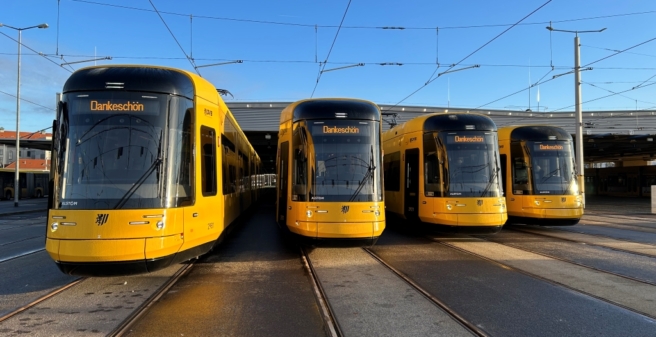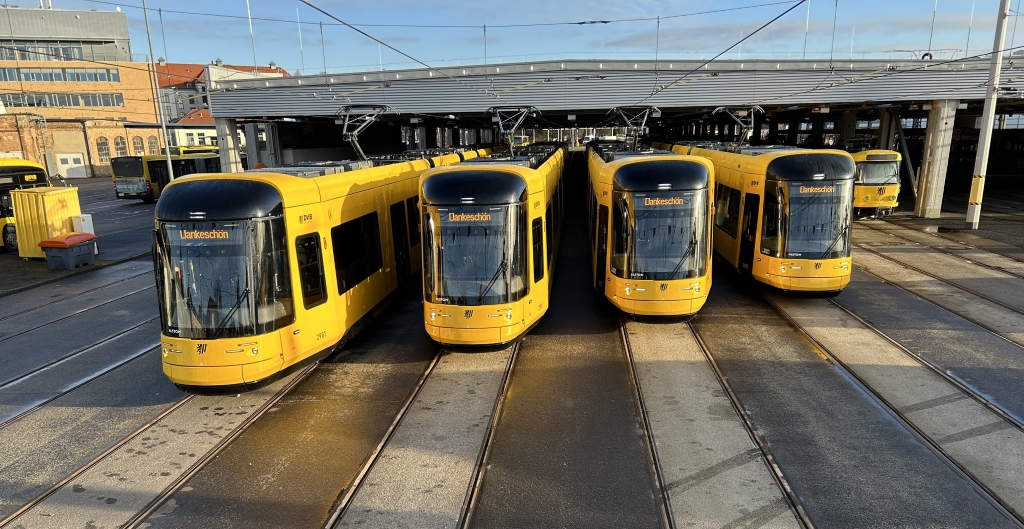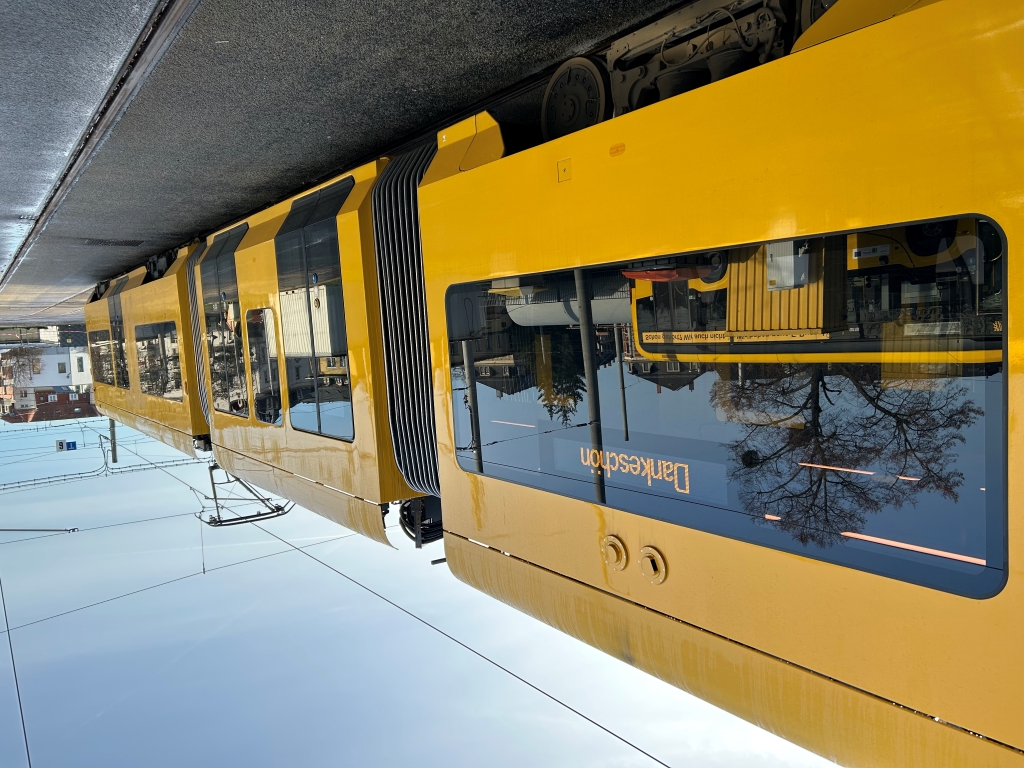
On 21 December 2023, the 30th new NGT DX DD light rail vehicle received its approval for the four-week trial run with passengers and started service immediately afterwards. This means that all 30 light rail vehicles ordered from vehicle manufacturer Alstom (formerly Bombardier) will have arrived at Dresdner Verkehrsbetriebe (DVB) and be ready for use before the end of 2023.
The 30 light rail vehicles were ordered in August 2019 following a Europe-wide tender and subsequently manufactured in Görlitz and Bautzen. Of these, 21 are designed as single-direction vehicles and 9 were built as bidirectional vehicles with a driver’s cab at each end of the vehicle and doors on both sides. The tender also included a maintenance contract to ensure DVB’s high quality standards for its passengers in the long term.
As of today, all 21 of the 30 vehicles delivered to Dresden have successfully completed their trial runs. On 24 November 2023, series approval was also granted for the bidirectional coaches. Three of them have also already completed their trial operation.
The NGT DX DD are currently being used on lines 2, 3 and 10. More are to be added in the future. Around three quarters of Dresden’s route network has already been prepared for the use of the new light rail vehicles. However, sections on Kesselsdorfer Straße and Königsbrücker Straße are still missing for line 7, which has the highest demand. Here, DVB is hoping for a speedy expansion of the streets.
As part of the tender for 30 vehicles, DVB has the opportunity to order a further ten vehicles of this type. Three vehicles have already been ordered and will arrive in Dresden in summer 2024. Discussions are underway with the Free State of Saxony regarding seven further light rail vehicles.
The first completed vehicle was given the number 232 901 and was presented to the public for the first time on 1 October 2021 in the presence of the Saxon Minister President. After an extensive commissioning and test phase of the first series vehicle, the first scheduled service with passengers followed on 26 November 2022. By the end of 2023, all other vehicles had arrived in Dresden and were put into operation.

More space and comfort
At 2.65 metres, the new vehicle is 35 centimetres wider than the light rail vehicles previously used in Dresden. At 43.5 metres, the new vehicle does not set a length record. However, the spacious interior can accommodate more passengers than the cars previously used in Dresden, namely up to 290, with two seats on each side. There is enough space between them so that passengers can easily pass each other in the aisle. In the multifunctional areas, there are four spaces for wheelchairs or pushchairs instead of the previous two. Up to six doors allow passengers to board and alight quickly and safely. Large LED light strips are fitted to the inside and outside of the doors. If they light up green, it is still possible to get in and out, but if they turn red, it is no longer worth sprinting to the door.
In addition to large panoramic windows, LED ambient lighting, the colour of which adapts to the
colour tone adapts to the time of day and season, and the bright interior panelling create a pleasant atmosphere in the car. There are more information monitors than before and they are clearly visible from all seats. A new feature is the use of air conditioning systems for the passenger compartment, which supply fresh air depending on the CO2 content in the interior. Compared to its predecessors, the new light rail vehicle consumes around 15 per cent less electrical energy for heating, air conditioning and lighting. WLAN technology for passengers is pre-equipped in all 30 vehicles. The free Wi-Fi is already active in 21 carriages; the missing nine carriages will receive their access during the next technical maintenance.
Challenges mastered
The production of the new Dresden light rail vehicles was subject to many challenges. Firstly, coronavirus and the freighter stranded in the Suez Canal caused a global shortage of raw materials and supplier parts. Then came the energy crisis with the war in Ukraine. As a result, the completion of the 30 cars was a long way off at times. The fact that all vehicles were nevertheless put into operation by the end of 2023 is primarily thanks to the above-average commitment of the employees at the manufacturer Alstom and DVB. It was not uncommon for them to pore over production chains, software updates and acceptance protocols late into the night. Pragmatic solutions were always found. The Free State of Saxony also played a major role in the success of the project by extending the deadline for the drawdown of funding until the end of 2023.
Funding available
The costs per vehicle amount to around 4.2 million euros. The total investment volume including production, service and long-term maintenance amounts to around 197 million euros.
The Free State of Saxony is providing DVB with 93.4 million euros in subsidies from the European Regional Development Fund (ERDF) and state funds for the purchase of the 30 light rail vehicles. DVB is receiving funding from the Free State of Saxony from the state investment programme for the purchase of the three optional vehicles, and talks are underway between DVB and the Free State regarding the purchase of a further seven vehicles.
Technical data
- Type NGT DX DD
- Low-floor articulated railcar (NGT) with 10 axles on bogies (DX)
- Length 43.5 m
- Width 2.65 m
- Number of seats (single-unit vehicle) 290
- Number of seats 96
- Number of standing places 194 Number of car parts 5
- Number of doors (furnishing vehicle) 6
- Maximum speed 70 km/h
(Info: DVB)


